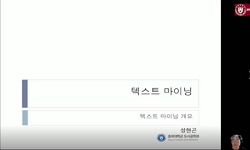본 연구는 트위터에서 나타나는 ‘자해’ 및 ‘자살’ 관련 게시물을 수집하여 주요 등장 단어와 핵심 토픽을 탐색하였다. 연구대상은 2019년 10월 29일부터 2020년 10월 30일까지 관련 해시태그...
http://chineseinput.net/에서 pinyin(병음)방식으로 중국어를 변환할 수 있습니다.
변환된 중국어를 복사하여 사용하시면 됩니다.
- 中文 을 입력하시려면 zhongwen을 입력하시고 space를누르시면됩니다.
- 北京 을 입력하시려면 beijing을 입력하시고 space를 누르시면 됩니다.
텍스트 마이닝 기법을 활용한 ‘자해’ 및 ‘자살’ 관련 SNS 게시물 분석 : 트위터 게시물을 중심으로 = Analysis of Twitter Post with ‘Self-Injury’ and ‘Suicide’ Using Text Mining
한글로보기https://www.riss.kr/link?id=T15955197
- 저자
-
발행사항
전주 : 전주대학교 일반대학원, 2021
-
학위논문사항
학위논문(석사) -- 전주대학교 일반대학원 , 상담심리학과 , 2021. 8
-
발행연도
2021
-
작성언어
한국어
-
주제어
비자살적 자해 ; 자해 ; 자살 ; 텍스트 마이닝 ; 트위터 ; Non-Sucidal Self-Injury ; Self-Harm ; Suicide ; Test mining ; twitter
-
발행국(도시)
전북특별자치도
-
형태사항
; 26 cm
-
일반주기명
지도교수: 권호인
-
UCI식별코드
I804:45016-200000513242
- 소장기관
-
0
상세조회 -
0
다운로드
부가정보
국문 초록 (Abstract)
본 연구는 트위터에서 나타나는 ‘자해’ 및 ‘자살’ 관련 게시물을 수집하여 주요 등장 단어와 핵심 토픽을 탐색하였다. 연구대상은 2019년 10월 29일부터 2020년 10월 30일까지 관련 해시태그를 포함한 게시물로 선정하였고, 자해 관련 해시태그 ‘#자해', ‘#자해계', ‘#자해러'와 자살 관련 해시태그 ‘#자살’, ‘#자살시도’, ‘#자살충동’, ‘#자살사고’, ‘#죽고싶다’, ‘#죽고싶어’가 사용되었다. 수집된 게시물을 바탕으로 텍스트 마이닝을 실시한 결과, 총 11개의 핵심토픽이 도출되었다. 첫째, 자해 관련 토픽은 '죽고 싶지만 자해하며 살아가고 있어', ‘칼로 내 몸을 긋고 있어', ‘자해하는 나를 탓하지 말아줘, 관심과 사랑을 주면 좋겠어', ‘나와 함께 이야기해줄 친구가 필요해', ‘자해 흉터는 나를 움츠러들게 만들어', ‘나는 정신장애와 함께 살아가고 있어'이었다. 둘째, 자살 관련 토픽은 ‘죽고 싶은 생각이 들 때는 도움을 요청하세요', ‘연예인 자살에 대한 반응들', ‘범죄 후 자살하는 사람들에 대한 엇갈린 시선들', ‘이젠 혼자 버틸 힘도 없으니 제발 날 좀 도와줘', ‘죽고 싶지만 자해하며 살아가고 있어'이었다. 이와 같은 결과는, 온라인상에서는 오프라인에서 표현하기 어려운 자해 및 자살의 경험을 솔직하게 표현할 수 있으며, SNS를 도움요청의 경로로 활용하고 있다는 것을 의미한다. 또한, 본 연구를 통해 자해 및 자살 관련 게시물에서 공유하는 공통적인 기능과 공유하지 않는 차별화된 기능이 존재하고 있음을 확인할 수 있었다. 이를 통해 자해 및 자살사고 경험자와 자해 및 자살 관련 이슈를 바라보는 대중의 의견을 이해하고, 자해 및 자살 예방 및 개입을 위한 효과적인 방안을 모색하여 기존의 정책에 대한 새로운 방향성을 제시하였다.
다국어 초록 (Multilingual Abstract)
This study explores key emerging words and key topics by collecting posts related to ‘Self-injury' and ‘Suicide' appearing on Twitter. The research subjects were selected as posts containing related hashtags from October 29, 2019 to October 30, 20...
This study explores key emerging words and key topics by collecting posts related to ‘Self-injury' and ‘Suicide' appearing on Twitter. The research subjects were selected as posts containing related hashtags from October 29, 2019 to October 30, 2020. Hashtags related to self-harm were #자해(Self-harm / Self-injury), #자해계(Self-injury account), #자해러(Self-injury ID), and hashtags related to suicide were #자살(Suicide), #자살시도(Suicide attempt), #자살충동(Suicidal ideation), #자살사고(Suicidal thoughts), #죽고싶다(want to die), #죽고싶어(want to die). Text mining based on collected posts resulted in a total of 11 key topics. The main message in the topic is as follows. First, self-harm topics were “I want to die, but I'm living with self-harm,", “I'm cutting myself with a knife.", “I need a friend to talk to me.”, “Don't blame me for hurting myself, I want you to give me attention and love.", and “I live with a mental disorder.". Second, suicide topics were “Ask for help when you feel like dying", “Response to celebrity suicide", “Opposing views on people committing suicide after a crime.", “Please help me because I don't have the energy to stand alone anymore" and “I want to die, but I'm living with self-harm". These results mean that offline, the experience of self-harm and suicide is frankly expressed and SNS is used as a route for requests for help. Through this, we understand the opinions of the people who have experienced self-harm and suicide accidents and the public regarding issues related to self-harm and suicide. This proposed a new direction by exploring effective measures for self-harm and suicide prevention and intervention in existing policies.
목차 (Table of Contents)
- 표 목차 ⅲ
- 그림 목차 ⅳ
- 국문 초록 ⅴ
- I. 서론 1
- 표 목차 ⅲ
- 그림 목차 ⅳ
- 국문 초록 ⅴ
- I. 서론 1
- 1. 연구의 필요성 1
- 2. 연구문제 6
- II. 이론적 배경 7
- 1. 비자살적 자해(Non-suicidal Self-injury) 7
- 2. 자살(Suicide) 11
- 3. 소셜 네트워크 서비스(SNS) 14
- 4. 빅 데이터 분석(Big-data analysis) 18
- 5. 선행연구 분석 20
- Ⅲ. 연구방법 23
- 1. 연구 대상 23
- 2. 분석 방법 25
- 3. 연구 절차 26
- IV. 연구결과 31
- 1. ‘자해’ 및 ‘자살’ 관련 트위터 게시물의 일반적 특성 31
- 2. ‘자해’ 관련 트위터 게시물 분석 결과 41
- 3. ‘자살’ 관련 트위터 게시물 분석 결과 60
- V. 논의 76
- 참 고 문 헌 92
- Abstract 110












